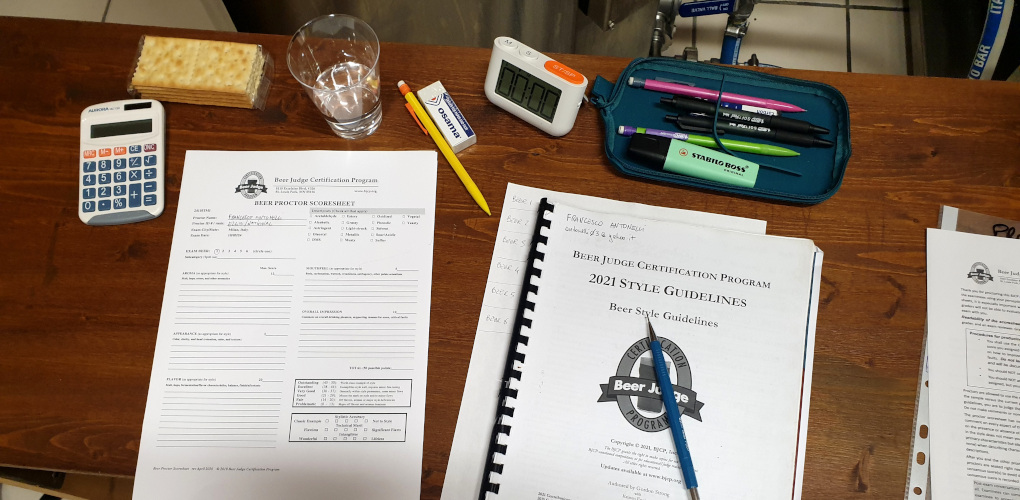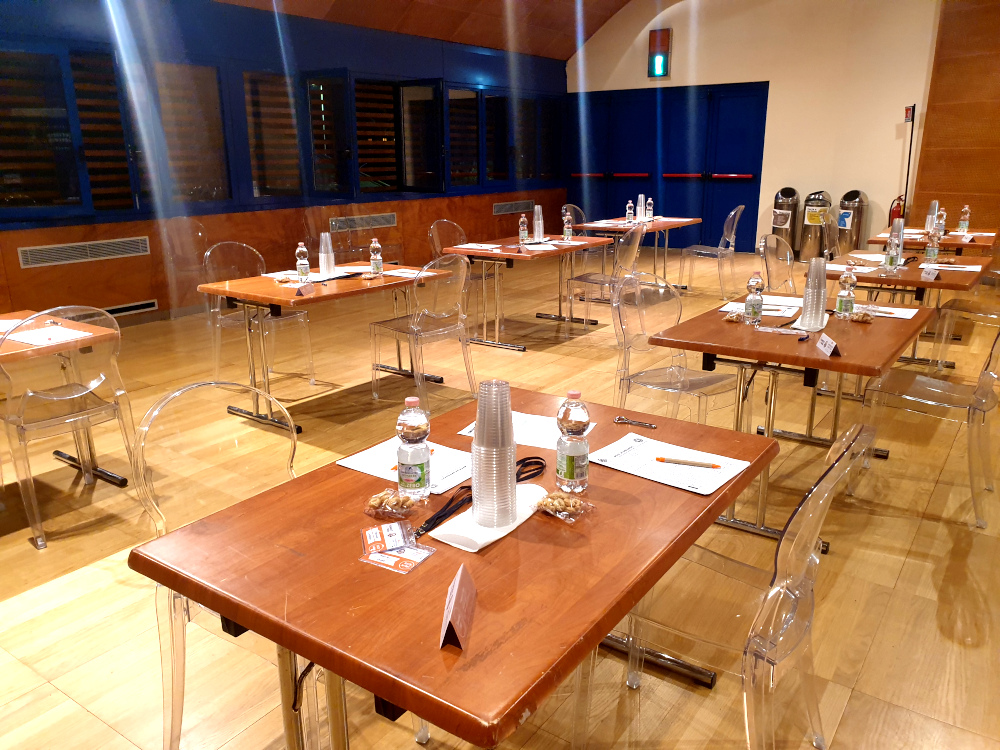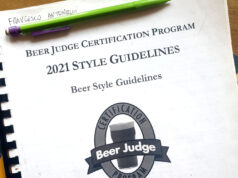Being a proctor for a BJCP Tasting Exam is a big responsibility. The proctors’ scoresheets are used as the reference when grading participants’ exam sheets. The proctor’s analysis of the beer will directly affect the candidate’s score.
It’s no accident that judges acting as proctors are required to be at least National level (exceptions do exist and must be authorized case by case).
So far I’ve been a proctor for three BJCP exams. More importantly, I’ve graded many. When you grade, you need to go through every scoresheet in the exam set carefully and compare them with the proctors’ scoresheets (there are two proctors per exam, sometimes three). I’ve seen some proctor scoresheets that were excellent, and others that made the grading process quite challenging on my side.
The BJCP has put together a short guide with practical tips for proctors that you can consult here. Still, I’d like to share some personal advice based on my experience both as a proctor and as a grader of BJCP tasting exams.
Bring the guidelines to the exam and use them
Proctors are allowed to consult the BJCP Style Guidelines during the tasting exam. That makes perfect sense, since they’re not the ones being tested and the exam beers need to be evaluated according to the BJCP guidelines.
Many proctors hesitate to check the guidelines during the exam (it also happens to judges during competitions). They’re probably worried about being seen as less competent if they do. But that’s absolute selfish crap.
A proctor who takes the time to review the guidelines during the exam is simply being careful and doing their job properly. It’s important to evaluate aspects like bitterness, dryness, clarity, and head retention based on the actual guidelines, not on vague memories.
Just like when judging in competitions, it would be careless to make a wrong assessment of the beer just because we misremembered the style specs.
If it were up to me, I’d tell the proctors what the exam beer styles will be a few days in advance, so they’d have time to review them properly. I get why that doesn’t happen — probably to keep too many people from knowing the exam styles ahead of time, and that makes sense.
So let’s just bring the guidelines to the exam and use them. Always.

Take your time, don’t rush
One thing that makes the Tasting Exam pretty challenging is time management. Scoring six beers in 90 minutes and filling out complete scoresheets isn’t easy. You need to be trained, well prepared, and able to stay calm.
Proctors, however, don’t have time limits for completing their sheets. They get the beers at the same pace as the exam takers, that is one every fifteen minutes; but when the 90 minutes are up, their scoresheets aren’t taken away immediately. Proctors can take as much time as they need to review, adjust, and finish their scoresheets.
Of course, that doesn’t mean you should spend three hours finishing your proctor scoresheets after the exam time has expired, but you can take a few extra minutes after each beer, even if the next one has already been served (it is important to still take a sniff of the beer as soon as it arrives, to detect any flaws in the aroma that might dissipate within a few minutes).
More importantly, as a proctor, you should take some extra time at the end of the exam to review your scoresheets and wrap things up.
It can also be helpful to go back over your scoresheets at the end of the exam and look at them as a whole, just to see if the scores you’ve given still make sense. You might even want to re-taste one of the beers if something comes to mind that you want to double-check or add (advice: leave some beer in the glasses after scoring each exam sample).
Obviously, it’s better not to rewrite everything from scratch, but a quick final review can help fine-tune your evaluations and maybe add a few useful notes here and there.

Comment on everything that is and isn’t in the beer
This is a very important point to help the judges who will later grade the exam. You always have to remember that the proctor is not being tested: their role is to analyze the beer and capture as much information as possible on the scoresheet.
A proctor does not need to show off great descriptive ability, they should be practical and above all thorough and accurate. It’s not important to describe the beer in an elaborate way; in fact that can be counterproductive. When graders correct the exam, they build an organoleptic matrix of the beer based on quantifiers, and use that to judge the perceptive ability of the candidates.
It is essential for a proctor to quantify every component of the beer precisely, leaving nothing out, and to follow the guidance on each part of the scoresheet
Avoid writing things like “some citrusy aroma” or “there is hop flavor” or just lists of descriptors such as “grapefruit, tropical fruit, peach”. With scoresheets like that it’s difficult to compare proctors’ impressions with those of the candidates.
The description of flavor is extremely important. I’ve seen many poetic descriptions that lack quantifiers or fail to consider key aspects of flavor like dryness or balance.
We don’t need poetry, we graders need pragmatism and attention to detail.
Don’t waste time or space suggesting how to fix things
One very important aspect for anyone taking a BJCP Tasting Exam is feedback. It’s essential to show both your stylistic knowledge and your technical understanding of the brewing process. These kinds of suggestions are usually included in the last part of the scoresheet – the Overall Impression section – though they can appear elsewhere, but that takes up valuable space.
For proctors, however, that’s not the case. They don’t need to prove anything. It’s completely unnecessary for a proctor to give advice on how to technically improve the beer in their scoresheet. It’s just a waste of space.
The last section of the sheet (Overall Impression) should instead be used by the proctor as a way to communicate with the grader, explaining why they assigned a certain score to the beer and what they consider to be the most important aspects summarizing its characteristics.
If there are flaws, how much did each flaw affect the overall evaluation? Is the balance right? Is the beer pleasant to drink? How well does it match the style guidelines, and if it doesn’t, which parameters push it out of style and by how much?
In an astringent beer, I wouldn’t waste time listing all the possible causes of astringency. Instead, I’d focus on clearly explaining the impact that astringency has on the beer — whether it makes it hard to drink, whether it’s negligible, or whether it exceeds what’s acceptable for the style. Even though astringency, theoretically, only accounts for a few points in the mouthfeel category, it can make a beer almost undrinkable.
Too often I’ve read proctor scoresheets without being able to understand what led them to the score they gave at the bottom. That makes grading difficult and can lead to evaluation errors.

Don’t look at other proctors’ scoresheets
I’ve been a proctor, so I know exactly how it feels at the end, when you compare your scores with the other proctor’s. If they’re too different, your first thought is, “Great, I’ve made a fool of myself.” It’s even worse when there are three proctors and the other two agree on a score. It feels lile “I’m the only moron who didn’t get it.”
I know. I’ve been there.
Sure, it can happen that you misread a beer and completely miss the mark — we’re all human, after all — but it’s important to put the proctor’s role into context. Having different opinions about a beer can actually be valuable. It gives the grader a broader perspective on the exam beer.
This is especially true for beers without clear flaws or that aren’t particularly great, where scores can naturally vary quite a bit in the middle of the scoring range.
I get that sneaking a look at the other proctor’s scoresheet can feel reassuring, but don’t do that. It would influence your evaluation and help no one.
It’s totally possible to misjudge a beer even as a proctor — nobody’s going to lose sleep over that. A good grader knows how to put things into perspective by looking at the other proctor’s sheets, the exam admin’s notes, and the participants’ sheets.
What really matters is forming your own opinion about each exam beer, based on your own experience and perception. That will help the grader. And completeness, but I’ve already stressed that enough.




